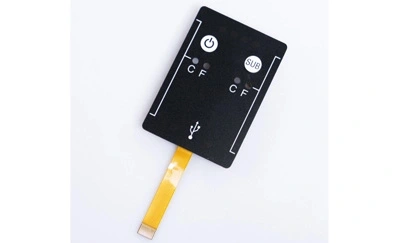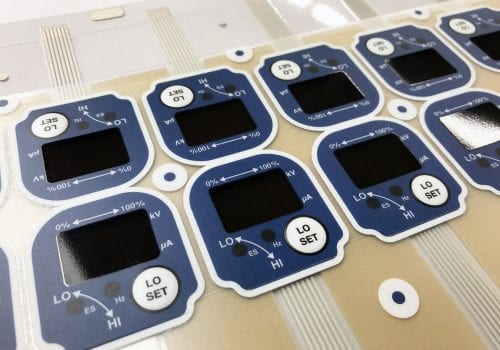Membrane switch and UI design: How to align function with form
Everything About Membrane layer Switch Over: A Comprehensive Overview for Beginners
Membrane layer switches are crucial parts in contemporary electronics, supplying an unique user interface for customer communication - membrane switch. Their split building, including overlays and conductive traces, supplies capability and resilience. Unlike traditional mechanical buttons, membrane buttons present a sleek style and adjustable choices. Comprehending their key features and advantages can transform item style. Nonetheless, the ins and outs of their application and design considerations necessitate additional expedition
What Is a Membrane layer Switch?
A membrane layer button is a sort of electric button that includes an adaptable membrane layer layered over a printed circuit board. This layout enables a streamlined and portable user interface, usually made use of in various electronic gadgets. Membrane buttons are generally found in consumer devices, clinical tools, and industrial equipment due to their toughness and resistance to environmental factors.The building commonly consists of numerous layers, such as graphic overlays and adhesive backing, which offer tactile comments and protect the wiring underneath. The procedure of a membrane layer switch is initiated when stress is put on the surface, completing an electrical circuit.These buttons are valued for their adaptability, allowing custom designs and printed graphics that cater to particular individual interfaces. Their inconspicuous nature minimizes area demands, making them excellent for applications where typical buttons may not fit. In general, membrane switches offer a visual and practical option for contemporary electronic devices.
Trick Parts of Membrane Layer Switches Over
Membrane layer changes comprise numerous crucial elements that contribute to their capability and efficiency. The top layer, referred to as the overlay, gives the interface and is typically printed with icons or graphics. Beneath the overlay exists a spacer layer, which separates the conductive components and protects against unintentional activation. The following important component is the visuals layer, which improves looks and ensures the sturdiness of the design.Conductive traces, usually made from products like silver or carbon, are published on the circuit layer. When stress is put on the overlay, these traces enter get in touch with, finishing the circuit. Furthermore, a backing layer uses structural assistance and can be made from materials such as polyester or polycarbonate. With each other, these components develop a reputable, straightforward interface ideal for different applications, from house home appliances to commercial equipment. Comprehending these elements is necessary for anyone curious about membrane button modern technology.
How Membrane Layer Switches Work
Recognizing how membrane switches over function is vital for valuing their widespread use in different tools. A membrane button runs via a series of layers, consisting of a visuals overlay, spacer, and a circuit layer. When stress is related to the overlay, it compresses the spacer layer, permitting the circuit layer to make contact and complete an electric circuit. This activity sends out a signal to the device, triggering an action, such as activating a light or activating a function.Membrane changes can be created with numerous attributes, consisting of responsive feedback, backlighting, and custom-made graphics, improving user interaction. Their building permits for a covered layout, protecting the internal components from dust, wetness, and pollutants. This longevity makes them ideal for varied applications, from customer electronic devices to commercial tools. Overall, the simplicity and effectiveness of membrane switches add to their appeal in modern-day innovation.
Benefits of Membrane Switches Over Mechanical Switches
While mechanical buttons have actually long been a staple in several tools, membrane layer changes deal distinct benefits that make them significantly appealing. One substantial advantage is their slim account, permitting more portable layouts and higher flexibility in product growth. In addition, membrane switches attribute a consistent surface, which enhances aesthetic allure and streamlines cleaning, making them suitable for environments where health is critical.Another advantage is their resistance to dust and dampness. Unlike mechanical buttons, which can be compromised by ecological aspects, membrane buttons offer a sealed user interface that safeguards against impurities - membrane switch. Additionally, membrane buttons usually have a longer life-span because of less relocating parts, causing improved resilience and reliability.Cost-effectiveness is additionally a remarkable advantage, as membrane buttons can be produced wholesale with lower production costs. These elements incorporate to position membrane layer buttons as a useful choice to conventional mechanical alternatives in various applications
Typical Applications of Membrane Layer Switches
Membrane buttons are widely utilized in numerous industries, specifically in consumer electronics and industrial control board. In consumer devices, they offer a streamlined, user-friendly interface, while in commercial setups, they enhance toughness and capability. Understanding these applications highlights the flexibility and functionality of membrane layer buttons in modern technology.
Consumer Electronics Gadgets
As customer electronic devices remain to advance, membrane buttons have actually come you can check here to be a prominent option for a variety of tools because of their adaptability and streamlined style. These buttons are generally found in smartphones, tablets, and remote controls, where space is limited and appearances issue. Their reduced account and personalized layouts permit makers to produce easy to use user interfaces that improve the overall user experience. Additionally, membrane layer buttons are usually made use of in devices such as microwaves and coffee manufacturers, supplying user-friendly control choices while resisting moisture and dust. The longevity and integrity of membrane switches make them ideal for day-to-day consumer products, making certain long life and constant performance. Overall, their assimilation in customer electronics mirrors a blend of functionality and modern-day style.
Industrial Control Panels
The applications of membrane switches over prolong beyond customer electronics, locating considerable use in commercial control panels. These buttons are favored for their resilience and resistance to rough atmospheres, making them optimal for making and process control setups. They give a dependable user interface for operators to regulate machinery, display processes, and readjust settings. Membrane layer switches can be personalized to suit certain operational requirements, including functions like backlighting and responsive feedback, boosting user experience. Their inconspicuous layout enables for assimilation into numerous equipment, while their capability to withstand spills, dust, and severe temperature levels assurances long life. Overall, membrane buttons contribute to safe and effective procedure in industrial applications, demonstrating their adaptability and effectiveness sought after settings.
Considerations for Designing Membrane Layer Switches Over
When creating membrane layer buttons, choosing the appropriate materials is vital to assure sturdiness and capability. Additionally, understanding layer configuration techniques can considerably impact the button's efficiency and customer experience. These factors to consider play an important role in creating efficient and trustworthy membrane layer button layouts.
Product Option Importance
Product selection plays a vital duty in the layout and capability of membrane layer buttons. The selected materials directly affect the switch's durability, tactile response, and total visual. Secret considerations include the substrate, which must provide architectural honesty while permitting versatility, and the graphic overlay, which needs to be immune to put on and ecological elements. Conductive materials need to ensure reputable electrical performance, while adhesives must supply solid bonding without jeopardizing the switch's procedure. Furthermore, compatibility with producing processes and end-user settings is crucial; materials must hold up against differing temperatures, moisture degrees, and chemical exposure. Ultimately, proper material selection not just boosts the helpful resources membrane switch's efficiency yet likewise adds to its long life and customer fulfillment, making it an essential element of the design procedure.

Layer Arrangement Techniques

Frequently Asked Inquiries
Exactly How Lengthy Do Membrane Switches Over Generally Last?
Membrane layer switches normally have a lifespan of 1 to 5 million cycles, depending upon use and environmental conditions. Variables such as style top quality and operating frequency substantially influence their longevity and overall performance durability.

Can Membrane Switches Over Be Personalized for Certain Styles?
Membrane switches can without a doubt be tailored to fit particular styles, permitting diverse forms, shades, and capabilities. This flexibility makes it possible for manufacturers to tailor these buttons to fulfill special visual and operational demands effectively.
What Materials Are Used in Membrane Switch Over Building And Construction?
Membrane layer switches are typically created making use of materials such as polyester, polycarbonate, and adhesive layers. These products supply flexibility, resilience, and resistance to environmental factors, making certain the switches work properly in different applications and conditions.
Are Membrane Layer Switches Over Resistant or water-proof to Wetness?
Membrane layer switches can be developed to be moisture-resistant, making use of specialized products and layers. Nonetheless, their waterproof capabilities depend upon building top quality and details applications, making it crucial to assess requirements for suitable efficiency in numerous settings.
How Are Membrane Layer Switches Fixed if Harmed?
Fixing damaged membrane switches generally involves replacing the affected layer or circuit. Specialists may also apply conductive glue or make use of specialized repair work kits, guaranteeing functionality is restored without full substitute of the entire switch assembly. Unlike traditional mechanical buttons, membrane layer switches present a streamlined layout and customizable options. A membrane layer switch is a more info here type of electric switch that consists of an adaptable membrane layered over a printed circuit board. The procedure of a membrane button is started when pressure is used to the surface, completing an electric circuit.These switches are valued for their versatility, making it possible for custom-made designs and published graphics that cater to details individual interfaces. While mechanical buttons have actually long been a staple in numerous tools, membrane switches offer distinct advantages that make them increasingly appealing. Membrane layer switches commonly have a longer life expectancy due to less moving components, resulting in improved durability and reliability.Cost-effectiveness is likewise a notable advantage, as membrane switches can be generated in bulk with reduced manufacturing expenses.